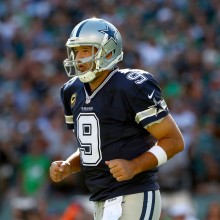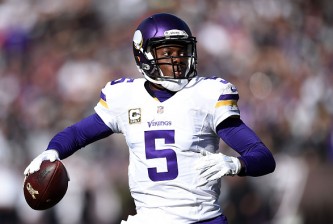
The NFL Draft is simply a very drawn out interview for each player. And from my experience, teams are more concerned with finding reasons NOT to take players, especially early. The more potential and the less concerns, the better.
Football is an obviously violent sport, and in the NFL, any hit could be a player’s last. That’s why injury checks are so crucial for incoming prospects, because teams don’t want to select a prospect, especially early, whose career might be littered with injuries, not be able to fully recover from a college injury, or suffer concerns that a player’s career may be shorter than it should.
Here are ten prospects with injury concerns coming into the draft:
Brandon Weeden, QB, Oklahoma State
Maybe surprising to some, he’s the least concerning prospect on this injury-wise based on the research I’ve done and people I’ve spoken with, including Weeden himself. He suffered a torn labrum and tendinitis in his right rotator cuff, which forced him to stop playing baseball. However, the difference in throwing motion and mechanics from a pitcher’s throw to a quarterback’s throw actually has no impact on his injury, and he’ll almost certainly never need surgery for this in the future. He also suffered a ruptured tendon in his right thumb, but played through it, so it shouldn’t be a long-term concern.
Bernard Pierce, RB, Temple
One of my favorite prospects in the entire draft, Pierce does not come without some concern as a prospect. Notably, he dealt with a severe ankle sprain in 2010 that limited him to five starts in a season where he was a pre-season Heisman hopeful. In 2011, he dealt with a concussion and a hamstring injury. In his three years as a starter, he’s missed at least one game per year. Along with that, he’s passed the 600 carry mark in his college career, always a concern for a running back.
Ryan Broyles, WR, Oklahoma
To begin this season, Broyles was slated to be a likely first round pick, perhaps college football’s top receiver, in the record books, maybe even a Heisman contender. But after an ACL injury that shut down his senior season, he’s fallen out of the minds of scouts in some cases.
Even for those who believe, he still needs to show that he still can fully recover his suddeness and deep speed, two things he wasn’t elite in to begin with. So far, it seems he’s answering those injury concerns well, and if that’s the case, the second round shouldn’t be out of the question.
Nick Toon, WR, Wisconsin
Toon has been dealing with foot injuries the past two seasons, and while they aren’t major red flags, lingering injuries in the lower half for any skill position player are crucial to note. He had turf toe and a thigh injury in his junior season, along with lingering foot injuries throughout most of his senior season. In such a deep receiver class, lingering injuries for a possession receiver may not be the best combination to have.
Chris Owusu, WR, Stanford
With the NFL’s focus on concussions in the game, Chris Owusu may be a lock to be out of the first two rounds of the draft almost immediately. In college, he had 3 concussions in a span of just over a year. While doctors have since completely cleared him, it’s important to note the case of Jahvid Best, former California running back and current Detroit Lion. Best had lingering concussion concerns from college, and after suffering two in his rookie season and starting only six games in 2011, he may have to consider life after football much earlier than anticipated. The same could be true for Chris Owusu.
Greg Childs, WR, Arkansas
With Ryan Mallett, Childs was arguably the go-to receiver in the offense, but after a patellar tendon injury in 2010, he was forced to sit the remainder of the season.
While he had surgery and recovered in time for the season, people I’ve spoken with are still concerned with the hitch in his step, and he may not possess the same cutting ability and lateral decisiveness to be much more than a vertical receiver at the next level. If that’s the case, then teams may write off Childs quickly from their board and look at the depth in this receiver class.
Andrew Datko, OT, Florida State
A shoulder injury early in his junior year was all set to be fully recovered and should have lead to a fresh start for his senior season. But more shoulder concerns forced the potential first round left tackle prospect to cut his season short just four games into his senior year. He decided to stop his pursuit of a medical redshirt and instead enter the NFL draft.
If his shoulder can completely check out, something I’m not sure will happen, he’s worth a second round pick for sure based on his talent and steady development as a left tackle. But shoulder injuries for a high impact position like tackle may be too concerning for teams to get over early in the draft.
Jared Crick, DT, Nebraska
As Walker Rhodes points out at OptimumScouting.com, the concern over Jared Crick’s pectoral muscle recovery is all based around if he can regain the upper body strength and explosiveness. He’s right around the end of his 4-6 month recovery process, and all reports claim it is going well, something we’ll find out more about as the process continues. He’s also dealt with a sprained MCL going into his senior season, an added concern for Crick on the injury front.
Josh Chapman, DT, Alabama
What an unusual case Josh Chapman is. He torn his ACL and his meniscus in his senior season as the Alabama nose tackle. The amazing part was, he didn’t miss a start. He played part of the season with a serious, surgery needing injury, while doing the dirty work that allowed for interior rushes by Courtney Upshaw and Dont’a Hightower.
Chapman had surgery roughly 6 weeks ago, and if the recovery process goes well, he should be back to being the gap-filling, immovable nose tackle he was at Alabama. But because teams may not know the future prognosis for Chapman, it may be tough for teams to get past the concerns for now.
Marcus Forston, DT, Miami (FL)
Forston has dealt with two fairly major injuries over his career at Miami. After a fantastic freshman season, he suffered an ankle injury that sidelined him for the majority of his sophomore season, which he got a medical redshirt for. Then, as a junior, he suffered a knee injury that prematurely ended his season. Forston still declared for the draft, a decision he reportedly made before the season. If he can prove he’s healthy, he’s flashed enough to be considered as an early- to mid-rounder.
Eric Galko is the founder of Optimum Scouting, providing year-round college and NFL prospect analysis on the Bloguin network. Follow him on Twitter at @OptimumScouting.






















